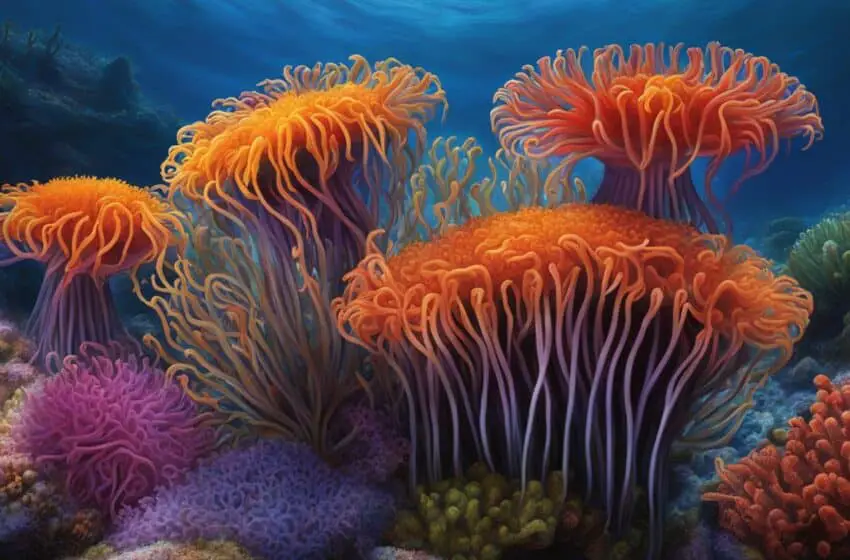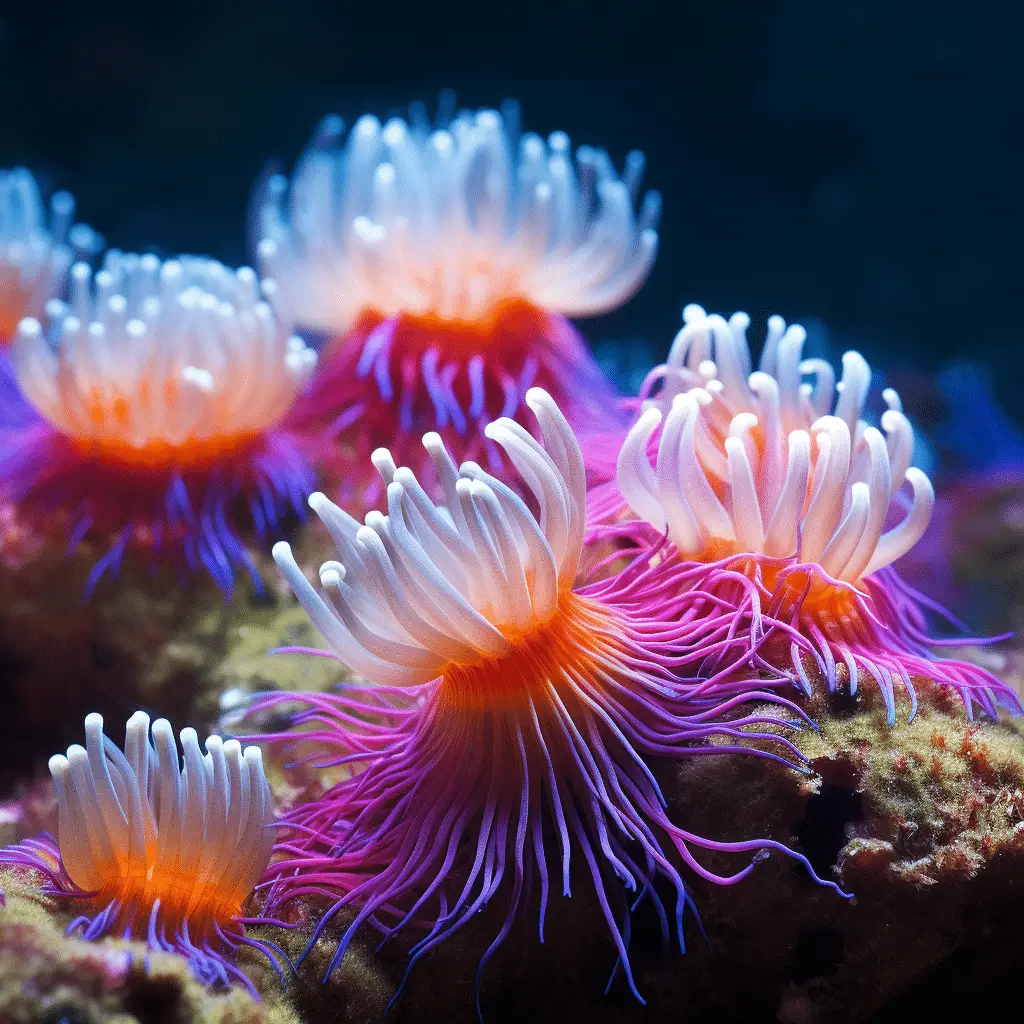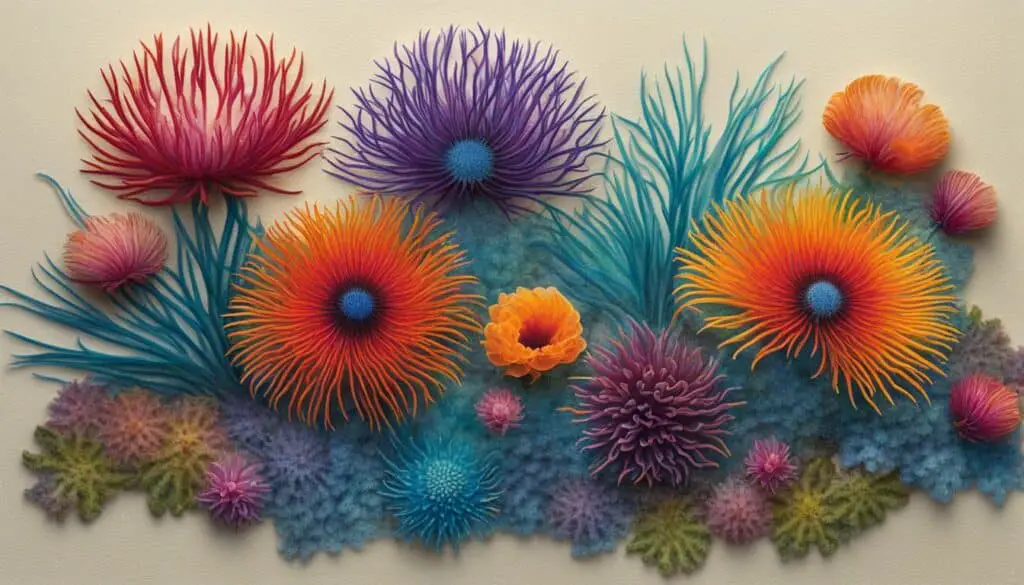Revealing Sea Anemone Reproduction: Strategies And Mysteries

Sea anemones, with their captivating beauty and mysterious nature, have long intrigued scientists and researchers. In this article, I will delve into the fascinating world of sea anemone reproduction, shedding light on their unique strategies and adaptations that contribute to their survival and success in diverse Pacific Ocean marine environments.
Key Takeaways:
- Sea anemones exhibit both sexual and asexual reproduction strategies, with some species dominated by clones.
- Factors such as habitat conditions, current velocity, and genetic traits influence sea anemones’ reproductive strategies.
- Sea anemones possess remarkable adaptations, including the ability to clone themselves and regenerate lost body parts.
- Their reproductive strategies involve external fertilization through the release of eggs and sperm into the water.
- Sea anemones play a vital role in marine ecosystems, providing habitat and food sources for other organisms.
Join me on this exploration of sea anemone reproduction, where we will uncover the mysteries and marvels of their reproductive cycle and how it contributes to the intricate web of life beneath the waves.
The Incredible Adaptations of Sea Anemones

Sea anemones possess remarkable adaptations that contribute to their reproductive success. They have the ability to clone themselves through asexual reproduction, allowing them to rapidly multiply and colonize new habitats. This asexual reproduction in sea anemones plays a crucial role in their ability to adapt and thrive in different environments.
Another fascinating adaptation of sea anemones is their regenerative abilities. If a sea anemone loses a body part, such as a tentacle, it has the remarkable capability to regenerate and grow a new one. This enables them to recover from physical damage and continue their reproductive activities with optimal efficiency.
Sea anemones also exhibit complex breeding habits and reproductive strategies. They can engage in both external and internal fertilization. Some sea anemones release eggs and sperm into the water, allowing for external fertilization to occur. Others, like certain species of sea anemones, have internal fertilization where the male deposits sperm directly into the female’s reproductive cavity. This diversity of reproductive strategies ensures the survival and genetic diversity of sea anemone populations.
Furthermore, sea anemones undergo a fascinating process of larval development. After the fertilization of eggs, larvae are formed and go through a developmental phase before settling on a substrate and growing into new individuals. This intricate life cycle contributes to the dispersal and colonization of sea anemones in marine ecosystems.
| Adaptations | Reproductive Strategies |
|---|---|
| Cloning through asexual reproduction | External fertilization and internal fertilization |
| Regeneration of lost body parts | Larval development |
The incredible adaptations and reproductive strategies of sea anemones showcase their resilience and ability to adapt to different environmental conditions. These unique qualities make them fascinating subjects for research and highlight their important role in marine ecosystems.
The Role of Sea Anemones in Marine Ecosystems
Sea anemones, with their diverse reproductive strategies and breeding habits, play a vital role in maintaining the balance and biodiversity of marine ecosystems. Their remarkable reproductive cycle and strategies contribute to their interactions with other species, shaping the dynamics of the underwater world.
The reproductive cycle of sea anemones involves a combination of sexual and asexual reproduction. Depending on the species and environmental conditions, sea anemones may reproduce by releasing eggs and sperm into the water for external fertilization. This process allows for genetic diversity and the creation of new individuals.
Furthermore, sea anemones can also engage in asexual reproduction, where they clone themselves to rapidly multiply and colonize new habitats. This capability not only aids in their survival but also provides crucial habitat and food sources for a variety of marine organisms.
One of the most intriguing aspects of sea anemone reproduction is their symbiotic relationship with clownfish. These two species rely on each other for survival and reproduction. The anemone provides shelter and protection for the clownfish, while the clownfish brings food and nutrients to the anemone. This mutualistic partnership showcases the intricate interdependencies within marine ecosystems.
In conclusion, the reproductive cycle, strategies, and breeding habits of sea anemones contribute to the overall health and biodiversity of marine ecosystems. Their ability to adapt to different environments ensures their presence and importance in the underwater world, underscoring the significance of studying and understanding these fascinating creatures.

FAQ
What is the reproductive cycle of sea anemones?
Sea anemones have a unique reproductive cycle that involves both sexual and asexual reproduction. They can reproduce asexually through cloning and also reproduce sexually by releasing eggs and sperm into the water for external or internal fertilization.
How do sea anemones adapt and reproduce in different environments?
Sea anemones possess remarkable adaptations that contribute to their reproductive success. They can clone themselves through asexual reproduction, regenerate lost body parts, and have complex breeding habits. These adaptations and strategies allow them to adapt and reproduce in various environments.
What role do sea anemones play in marine ecosystems?
Sea anemones play a crucial role in marine ecosystems by providing habitat and food sources for a variety of marine organisms. Their reproductive cycle and strategies can impact their interactions with other species and contribute to the overall balance and biodiversity of marine ecosystems.



